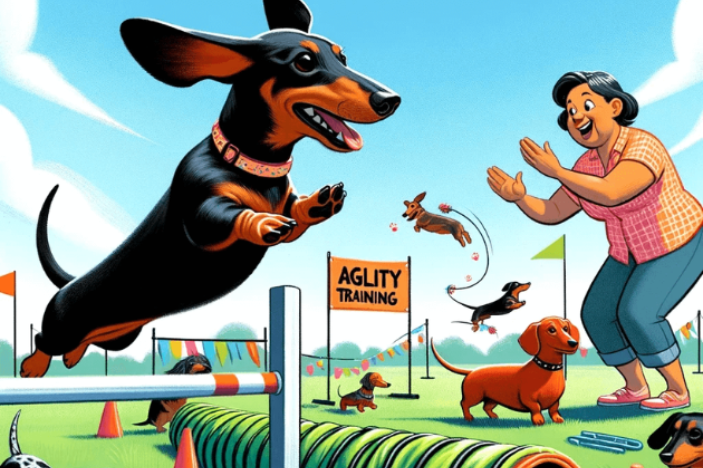Dachshunds, also known as wiener dogs, are a breed of small dogs that come in two sizes: standard and miniature.
Both male and female dachshunds are known for their feisty and lively personalities, but there may be some differences in their behavior and temperament.
Male dachshunds tend to be more outgoing and independent than females. They are also generally more adventurous and curious and may have a stronger tendency to explore their surroundings.
However, male dachshunds may also be more territorial and dominant, which can sometimes lead to aggressive behavior toward other dogs.
Female dachshunds, on the other hand, tend to be more affectionate and attentive to their owners. They are often more social and enjoy spending time with other dogs, and may be less likely to exhibit territorial behavior. However, female dachshunds can also be more stubborn and difficult to train than males.
It’s important to note that every dog is unique and may have their own personality traits regardless of their gender.
Additionally, a dachshund’s personality can be influenced by factors such as upbringing, socialization, and training
Male and female dachshunds look different.
Yes, male and female dachshunds can have slight physical differences in terms of size and weight. Generally, male dachshunds tend to be slightly larger and heavier than females.
Male dachshunds can weigh between 16 to 32 pounds (7 to 14 kg), while females typically weigh between 12 to 28 pounds (5 to 12 kg).
In terms of appearance, male and female dachshunds can have differences in their body structure as well.
Male dachshunds may have a more muscular and sturdy build, with a broader chest and a thicker neck.
Female dachshunds, on the other hand, may have a more streamlined and graceful appearance, with a narrower chest and a slimmer neck.
It’s important to note that these differences are not always noticeable, and every dog is unique regardless of their gender.
Additionally, a dachshund’s physical characteristics can be influenced by factors such as its diet, exercise routine, and genetics
Physical differences
There are a number of physical differences between males and females that are related to biology and reproductive functions. Here are some of the most common differences:
- Body Size and Shape: Men typically have larger bodies and more muscular frames than women. Women tend to have wider hips and a narrower waist, while men have broader shoulders and a more rectangular shape.
- Reproductive Organs: Men have a penis, testes, and prostate gland, while women have a uterus, ovaries, and vagina.
- Hair Growth: Men tend to have more body hair and facial hair than women, due to higher levels of testosterone.
- Voice: Men typically have deeper voices than women, also due to the effects of testosterone.
- Hormones: Men have higher levels of testosterone and lower levels of estrogen, while women have higher levels of estrogen and lower levels of testosterone.
- Muscle Mass: Men tend to have more muscle mass than women due to the effects of testosterone.
- Fat Distribution: Women tend to carry more fat around their hips and thighs, while men tend to carry more fat around their midsection.
- Bone Density: Women generally have lower bone density than men, which can make them more susceptible to osteoporosis.
It’s important to note that not all men and women will exhibit the same physical characteristics, and there is a wide range of variation within both sexes.
Additionally, gender is a complex and multifaceted concept that goes beyond biology and includes social, cultural, and psychological factors.
Men vs Women: Which Is Better With Kids?
It is not appropriate to say that one gender is inherently better than the other when it comes to parenting or caring for children. Both men and women can be loving, nurturing, and effective caregivers.
Research has shown that children benefit from having both male and female role models in their lives. Fathers, for example, have been found to play a unique and important role in their children’s development,
Particularly in areas such as social and emotional development, language development, and cognitive development. At the same time, mothers are typically the primary caregivers in many cultures and are often seen as the emotional support and nurturer in the family.
Ultimately, what matters most in raising children is not gender, but the quality of the relationship between the caregiver and the child, as well as the caregiver’s ability to provide a safe, stable, and nurturing environment.
Each family is unique, and the roles and responsibilities of parents and caregivers can vary depending on individual circumstances, such as work schedules, family dynamics, and cultural traditions
Men vs Women: Who’s Better With Cats?
There is no inherent difference between men and women when it comes to their ability to care for cats. Both men and women can make excellent cat owners and caregivers.
Caring for a cat involves providing food, water, shelter, and medical care, as well as offering love, attention, and playtime. These tasks do not require any specific gender-based skills or abilities but rather depend on the individual’s willingness and ability to meet the needs of their feline companion.
However, studies have shown that there may be some gender-based differences in the ways that men and women interact with cats.
For example, one study found that women were more likely to engage in play with their cats, while men were more likely to engage in rough play or pet their cats for shorter periods of time.
Another study found that women were more likely to perceive their cats as family members, while men were more likely to view their cats as companions or workers (e.g., for pest control).
Ultimately, these gender-based differences are likely due to individual personality traits and preferences, rather than any inherent gender differences.
The most important factor in being a good cat owner is to be responsible, attentive, and loving, regardless of gender
Men vs Women: Which Is Better With Families?
It is not appropriate to say that one gender is inherently better than the other when it comes to caring for families. Both men and women can be loving, nurturing, and supportive family members.
Families come in all shapes and sizes, and the roles and responsibilities of family members can vary depending on individual circumstances, such as cultural traditions, family dynamics, and personal preferences.
In many cultures, women are often seen as the primary caregivers and emotional support for their families, while men may take on more traditional roles as providers and protectors. However, these roles and responsibilities are not fixed or exclusive to one gender, and many families today embrace a more egalitarian approach to family life.
What matters most in caring for families is not gender, but the quality of the relationship between family members and their ability to communicate, collaborate, and support each other.
It is important for all family members to be willing to listen, compromise, and work together to overcome challenges and celebrate successes. Both men and women can be valuable contributors to the well-being of their families, and it is important to recognize and appreciate the unique strengths and talents that each individual brings to the table.
Male vs Female Dachshund Health
Dachshunds, like all dog breeds, can be prone to certain health issues regardless of their gender. However, there are some health concerns that may be more common in male or female Dachshunds. Here are a few examples:
Male Dachshund health concerns:
- Testicular cancer: Intact male Dachshunds have a higher risk of developing testicular cancer than females, and neutering can significantly reduce this risk.
- Prostate problems: Older male Dachshunds may develop prostate problems, such as prostate enlargement or inflammation, which can cause urinary problems.
- Back problems: Dachshunds are a breed that is prone to intervertebral disc disease (IVDD), which can cause back pain, mobility issues, and in severe cases, paralysis. Neutering may also increase the risk of developing IVDD.
Female Dachshund health concerns:
- Mammary tumors: Female Dachshunds who are not spayed have a higher risk of developing mammary tumors, which can be cancerous.
- Pyometra: This is a serious infection of the uterus that can occur in unspayed females and requires immediate veterinary attention.
- Back problems: Like male Dachshunds, females are also prone to IVDD, which can cause back pain, mobility issues, and in severe cases, paralysis.
It is important to note that the health of a Dachshund is not solely determined by their gender, but by a combination of factors such as genetics, environment, diet, and lifestyle.
Regular veterinary check-ups, a healthy diet, exercise, and preventative care such as vaccinations and parasite control can all help maintain a Dachshund’s overall health and well-being, regardless of their gender
Result
In conclusion, while there may be some general differences in personality traits between male and female Dachshunds, individual variations are much more significant.
Personality traits in Dachshunds, as in all dogs, are influenced by a complex interplay of genetic, environmental, and individual factors, which makes it difficult to make broad generalizations based solely on gender.
Ultimately, the key to a happy and well-adjusted Dachshund is to provide plenty of love, attention, and positive reinforcement training, regardless of their gender.
With proper care, socialization, and training, male and female Dachshunds can make wonderful and beloved companions for their human families




